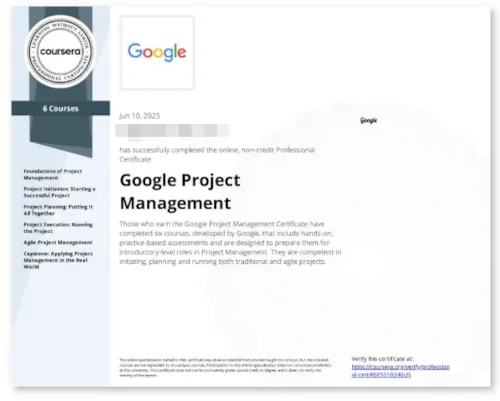In this article, I’m going to share my experience with the Google Project Management course on Coursera – a comprehensive program about project management that, as the name suggests, is taught by Google.
I’ll tell you what it’s all about, what topics it covers, how long it took me to complete, what I paid, and what I thought of it.
So if you’re thinking about taking this course, I highly recommend reading through this first.
Google’s Project Management Course
First things first – this is an official Google course. In fact, the instructors are Google employees, and while some of the topics they cover are generic project management concepts, you could say they definitely have a Google spin on things.
Now, here’s the thing – the course isn’t really a course. It’s actually a professional certificate program. What does that mean? It’s really 6 courses in one. So keep in mind that you’ll need quite a bit of time to get through everything.
How the Program Works
Let’s get to the important stuff. The program is hosted on Coursera, so as you might guess, it’s 100% online. In theory, it’s available in different languages, but I did the whole thing in English.
You decide when to study and work through the lessons. These lessons can be videos where instructors explain concepts, readings, or interactive activities. Some of these activities are pretty good, but honestly, most of them are kind of boring.
Cost and Time Commitment
How much do you have to pay to complete this program, get the certificate, and upload it to LinkedIn just like I did? Well, that depends on how much time and money you have available.
The course costs $39 per month. And how long does it take? As long as you want. You can do it in one month and pay $39, or take several months and pay more. The longer you take to complete the program, the more you’ll pay.
I buckled down and finished it in one month, so I only paid $39. To do this, I set aside about 4 hours per day (including Saturdays, but not Sundays).
To give you an idea – and I’ll explain this more in a moment – the program is divided into courses, courses into sections, and sections into modules. I did roughly one module per day.
I strongly recommend that if you’re going to try to complete the course in less than a month, plan out how many modules you should do per day or per week.
Alright, let’s talk about the content, which is probably what you’re most interested in.
Course Breakdown
The first course is a bit of a slog. It’s called Foundations of Project Management and it’s loaded with introductions, including the infamous introduction to the introduction. You’ll learn what project management is, what a project manager does, what industries or businesses they can work in, and things like that.
The second course is one of the best. They explain how a project begins – what resources are available, what a project proposal is, what a project charter is, how to create a project charter, and what tools a PM has at their disposal.
The third course is another interesting one. It starts by covering topics related to communication and documentation, including project organization.
The fourth course is about executing the project – how to maintain metrics to track progress, make corrections, manage dependencies, handle risks, and learn when to escalate issues to leadership.
The fifth course is project management using agile methodologies. I found this one pretty dull because I’ve been working with agile methodologies for years. However, if you don’t know much about it and you’re interested, you can probably learn a lot. There’s quite a bit of theory, but it’s all well explained. You learn about Agile in general, and then everything moves into Kanban and Scrum, with all the ceremonies involved.
The last course is supposedly a kind of summary where you apply concepts explained in the other courses, but the truth is this only applies to the first part of the project, not the whole thing. Honestly, I didn’t like this last course at all. The practical example they used is a bit convoluted, and I found the activities unbearable. Either way, I did them as best I could.
Assessments and Practical Activities

Throughout the course, you’ll encounter quizzes. The ones that appear in the middle of a module are short and designed to help you absorb certain concepts. They’re super easy.
Then, at the end of each module, there’s an “exam” – and I put that in quotes because it’s really just a regular quiz, but timed. The thing about these is they’re usually at least 10 questions, a bit harder, and if you fail three times in a row, you have to wait 24 hours before you can retake it. Obviously, this blocks your progress to the next sections of the course.
In these end-of-module exams, the questions don’t usually repeat each time. The difficulty is still low, but you need to pay attention and complete the activities and read all the texts. You can reference all the material while taking the exam, which usually has a 50-minute maximum. In practice, I finished most quizzes in less than 15 minutes, reviewing my answers ten times before submitting.
You get your grade almost instantly, which lets you move forward with the course.
As for the practical activities, they generally consist of taking a Google Drive template provided by the course and completing it following the exercise instructions. So you’ll need a Google account to take this course and access these Google Drive documents.
After completing it, you have to confirm you did it and move forward. Then you’ll see the completed exercise to compare. With what I’m telling you, you might be tempted to skip the exercise and just move on. I wouldn’t recommend that because you won’t be able to quickly solve the quizzes later.
Besides, if you’re not doing the exercises, what’s the point of taking the course?
Peer Review
Now I want to tell you about the most annoying part of this Coursera course (and I understand, of any Coursera course): peer review and its problems.
If you don’t know what it is, peer review is an activity you have to complete and submit for another student in the same course to grade. In turn, you have to grade other students’ activities.
What’s the point of all this? I understand it’s a form of validation for Coursera to ensure there’s actually a person on the other end who’s really doing the activities.
In this entire Google Project Management course, there’s only one peer review activity, and it’s in the last course. The activity itself is super simple – it’s writing an email in the context of the course topics.
The big problem is the peer review itself. You complete the activity and wait to be graded. That’s when the Coursera trolls appear and give you a bad grade. This forces you to resubmit your activity with changes. But if this happens to you, like it did to me, don’t change anything – just resubmit it as is until a sensible student shows up who, like you, is also taking the course. If I remember correctly, you need 3 good grades to pass and get this headache off your back.
Once you submit your part, you earn the ability to grade others. You have to do at least 3 reviews, but you can do more if you want.
For me, this whole thing took about two or three hours. I did the activity in 5 minutes, but then I had all this back and forth of modifying the activity, resubmitting it, and waiting.
Is This Program Worth It?
I’m going to be 100% honest with you: it depends.
If you already have a lot of experience in project management – for example, if you’ve already led several projects or have several years leading one – I really don’t think you’ll gain much knowledge from this program. On the contrary, I’d say you’ll find it unbearably slow and tedious. While it’s true you always learn something from everything, I think there are better resources for people who already have experience.
On the other hand, if you have no idea about project management and administration, this course is very good. It works as a theoretical introduction and gives you an overview of a PM’s day-to-day work. I’d highly recommend it if you’re just starting this project management journey, or if you’d like to see if this is for you or not.
And keep that last part in mind. I recently read that project managers are the professionals with the highest stress levels. That doesn’t surprise me.
For me personally, the program caught me somewhere in the middle, so to speak. I’ve had a lot of experience as a project leader, but I don’t feel like one. So I learned a lot from the theoretical part, but I don’t know how much of it I’ll actually apply someday.
Tips for Taking This Course
From my experience, here are some tips for this course:
Planning: Figure out how many modules there are and distribute them across the days you can study. Create a whole calendar with the most important milestones – meaning when you’d finish each course and when you’d complete the certification.
Note-taking: I highly recommend taking notes as you go. I did this course with one Coursera window and another with Obsidian next to it, where I jotted down what seemed most relevant, establishing links between documents.
Attention: At times, the course gets a bit tedious and boring. This is very relative, as it depends on what topics interest you. But if this happens to you, don’t stop paying attention. The tests are simple, but if you’re in zombie mode, they can give you a headache. The more attention you pay, the faster you’ll be able to solve them.
Wrapping Up
If you’re interested in project management and don’t have much experience, this Google course on Coursera is a good way to take a first step into this world that’s as exciting as it is challenging.
If you want to learn more about the program, check out the official course details, or see the current pricing and schedule, head over to the Google Project Management Professional Certificate on Coursera. It’s worth browsing through the syllabus to see if it aligns with what you’re looking for in your PM journey.

